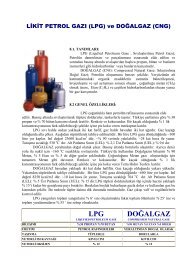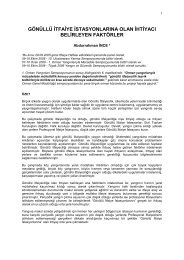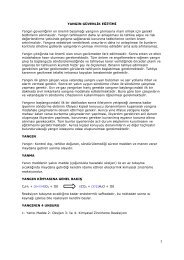buradan - Yangın
buradan - Yangın
buradan - Yangın
Create successful ePaper yourself
Turn your PDF publications into a flip-book with our unique Google optimized e-Paper software.
TÜYAK BİLDİRİLER KİTABI<br />
2009 PROCEEDINGS BOOK<br />
USING SENSOR INTEGRATION AND GEOGRAPHIC INFORMATION SYSTEMS (GIS)<br />
TO AUTOMATE WIDE AREA SURVEILLANCE AND<br />
PROVIDE SITUATIONAL AWARENESS<br />
Daniel John FLYNN<br />
Honeywell<br />
Abstract<br />
Wide Area Surveillance has typically been labor intensive, with<br />
surveillance provided by security personnel monitoring the site<br />
directly or through CCTV. These methods of surveillance are<br />
expensive and not reliable, as humans fatigue and are not well<br />
suited to monitor a wide area. Sensor technologies such as<br />
electronic fences, microwave sensors, underground sensors, and<br />
infrared sensors have provided some relief, but these systems<br />
demand substantial infrastructure and construction investment,<br />
and have high maintenance costs. The recent introduction of<br />
commercial radar, GPS sensors, and GIS platforms now enable<br />
cost effective automation of wide area surveillance, and also<br />
provide single screen situational awareness. When integrated with<br />
life safety sensors, these systems can automatically monitor and<br />
react to both security and life safety events. This paper explores the<br />
deployment of these technologies using a Radar Video Surveillance<br />
(RVS) system to cost effectively and reliably automate wide area<br />
surveillance.<br />
Sensör Entegrasyonu ve Coğrafi Bilgi Sistemlerinin<br />
Kullanılması ile Geniş Alan İzlemelerinin Otomasyonu<br />
ve Durumsal Farkındalığın Sağlanması<br />
Özet<br />
Geniş alanların güvenlik amaçlı izlenmesi, genellikle emek yoğun<br />
bir iş olmuş ve güvenlik personelinin doğrudan ya da CCTV sistemi<br />
yardımı ile gerçekleştirdiği bir denetimden öteye geçememiştir. Bu<br />
tip izleme metodları hem pahalı, hem de insanın zamanla yorulma<br />
faktörü göz önünde bulundurulduğunda güvenilirliği düşük, geniş<br />
bölgelerin denetimi için uygun olmaktan uzak yöntemlerdir.<br />
Elektronik çitler, mikrodalga sensörleri, yer altında kullanılan<br />
sensörler ve kızılötesi (infrared) sensörleri gibi algılama teknolojileri<br />
bu probleme belli bir seviyede çözüm getirmiş olsalar da, önemli<br />
inşai ve altyapısal maliyetler oluşturmakta ve beraberinde yüksek<br />
bakım maliyetlerine sebep vermektedirler.<br />
Son dönemde, ticari radarlar, GPS (küresel yer belirleme) sensörleri<br />
ve GIS (coğrafi bilgi sistemi) platformunun kullanıma girmesi, geniş<br />
alanların güvenlik amaçlı izlenmesi ve otomasyonunun maliyet<br />
etkin bir şekilde gerçekleştirilmesine ve izlenen bölgede olup<br />
bitenden tek bir ekran üzerinden haberdar olunmasına olanak<br />
sağlamıştır. Can güvenliği sistemlerinde kullanılan sensörler ile<br />
entegrasyonları sağlandığında bu sistemler, hem güvenlik hem de<br />
insan hayatını tehlikeye atan olaylar ile ilgili otomatik olarak izleme<br />
yapma ve bu olaylara reaksiyon verebilme yetisine sahiptirler. Bu<br />
2<br />
TÜYAK 2009<br />
bildiri, sözü geçen teknolojilerin, Radar Video İzlemesi (Radar<br />
Video Surveillance – RVS) sistemi kullanılarak, geniş alanların<br />
güvenlik amaçlı izlenmesi ve otomasyonunun maliyet etkin ve<br />
güvenilir bir şekilde gerçekleştirilmesini incelemektedir.<br />
Summary<br />
A single surveillance position manned 24/7/365 with weekends,<br />
vacations, and holidays require five full time personnel. In many<br />
cases, this fact alone makes a compelling case to automate<br />
surveillance with an RVS system, to reduce cost and increase<br />
effectiveness.<br />
Sensors<br />
Marine Radar<br />
AIS<br />
Ground Radar<br />
GPS<br />
Detect<br />
Situational Awareness<br />
Processor<br />
Track, Display, Prioritize<br />
Security<br />
Systems<br />
Respond<br />
Figure 1. Wide Area Surveillance is automated by using sensors<br />
to Detect, software to Track, Display, and Prioritize, and cameras<br />
to Respond.<br />
An RVS system receives and processes data from all detection<br />
sensors, and determines when a potential threat may exist based<br />
on user defined rules. All detections are processed and prioritized,<br />
and when a threat’s priority exceeds a database defined threshold,<br />
an alarm is generated and a response occurs. The response is<br />
typically to automatically steer a CCTV camera to the location<br />
of the threat, but may also include shutting down processes,<br />
changing access control options, or initiating an operator response<br />
checklist.<br />
When using an automated wide area surveillance system such<br />
as this, an operator can perform other tasks, only responding to<br />
an event after the software has prioritized it as a potential threat.<br />
These events can be intrusions or life safety alarms, or other<br />
scenarios defined by the user defined rules.<br />
The three components of an RVS system are sensors to detect,<br />
software to track, display, and prioritize, and cameras to respond.





